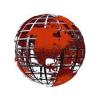

| Visitors Now: | |
| Total Visits: | |
| Total Stories: |

| Story Views | |
| Now: | |
| Last Hour: | |
| Last 24 Hours: | |
| Total: | |
As Conclave 2013 Commences To Choose Next Pope, Black Smoke Expected First Day
On the eve of the conclave, final preparations are taking place at a feverish pace. Monday afternoon the necessary staff and personnel will be sworn in, as is required by apostolic constitution. Tuesday the 115 electoral cardinals will begin the day early, entering the Santa Marta residence and attending papal pro eligendo mass. The first smoke will “in all probability” be black, according to the spokesman for the Holy See, Fr. Federico Lombardi. In any case, it will be a test of people’s eyesight: starting Tuesday, weather in Rome is expected to take a turn for the worse, with rain forecast all week long.
Cameras for the Vatican television center will be focused on the little chimney of the Sistine Chapel, broadcasting live morning and afternoon, “just so no one will be caught off guard,” Lombardi joked. The inaugural mass for the new pope will not have to be held on a Sunday, but can take place during a weekday instead.
Some statistics and numbers provide past comparison: “In 2005,” Lombardi said, “black smoke was seen first thing in the morning at 11:52, while white smoke wasn’t seen until 5:50 p.m.” Here’s a look at how long various conclaves have lasted:
1903 – Pope Pius X (3 days, 7 elections)
1914 – Pope Benedict XV (4 days, 10 elections)
1922 – Pope Pius XI (5 days, 14 elections)
1939 – Pope Pius XII (2 days, 3 elections)
1958 – Pope John XXIII (4 days, 11 elections)
1963 – Pope Paul VI (3 days, 6 elections)
1978 – Pope John Paul I (2 days, 4 elections)
1978 – Pope John Paul II (3 days, 8 elections)
2005 – Pope Benedict XVI (2 days, 4 elections)
More: http://www.huffingtonpost.com/2013/03/11…lp00000009
2013-03-11 18:49:35
Source:


